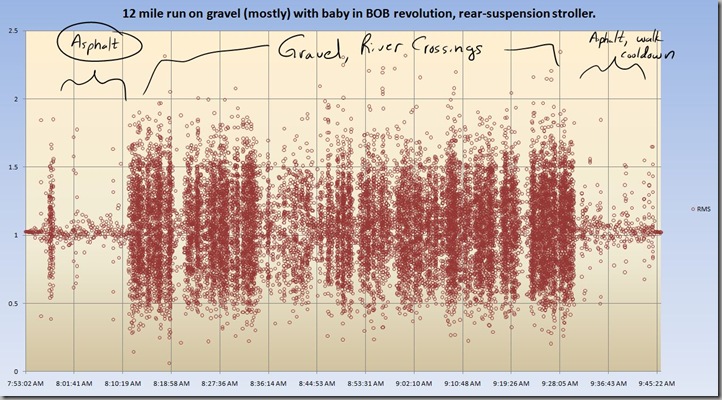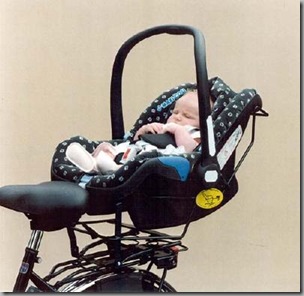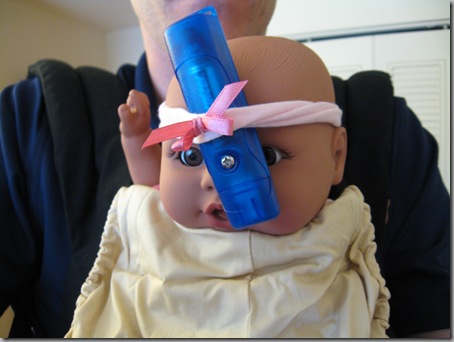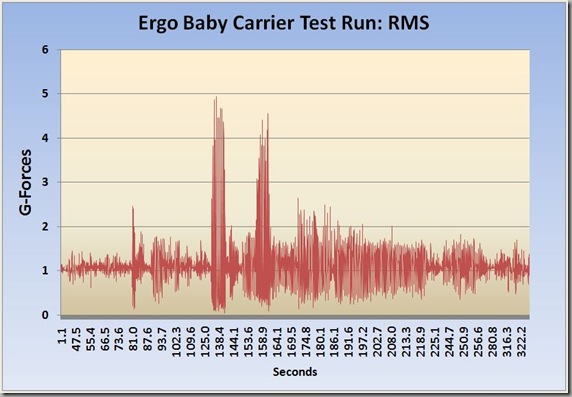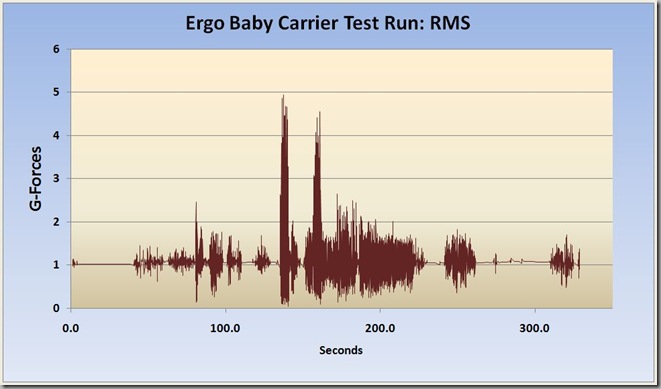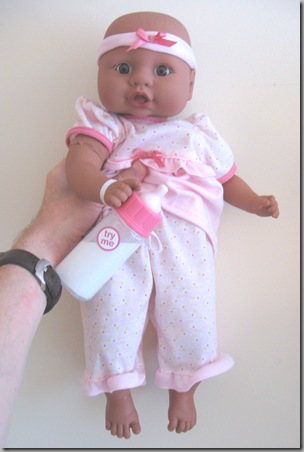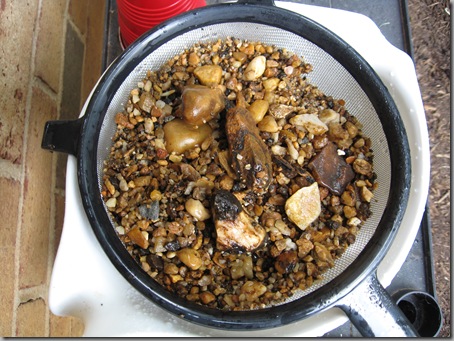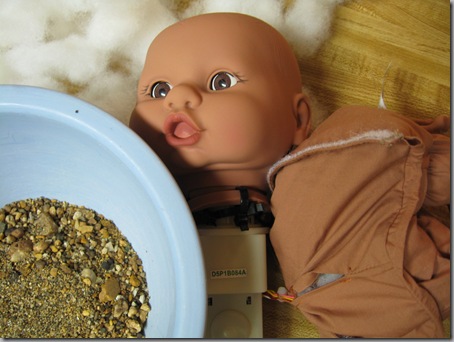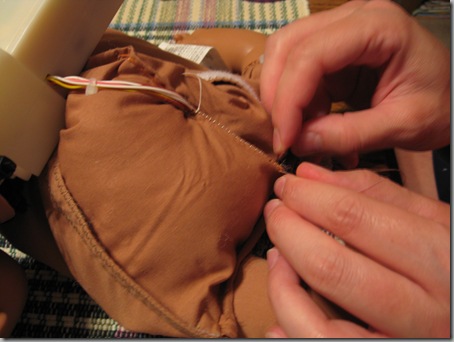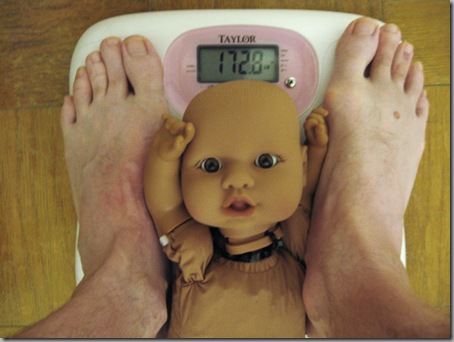Sunday, May 23, 2010
Friday, September 11, 2009
More Trailer Data
I recently re-vamped the Burley Solo. It was, at the time of the last Chuckette test, equipped with a suspended mesh seat, laid flat to accommodate the dog. That put the child carrier directly in contact with the axel on bumps. (And the dog, too. No wonder he seemed ornery.) I ordered new seat mesh, installed it to get the trailer back to stock, and ran Chuckette over the really rough trail, as well as the smooth asphalt, to see what kind of RMS G-forces were produced by the infant car seat in the bike trailer in the more stock configuration. This Burley Solo is a bit old, and has no suspension. Tests on Chuckette with a suspended BOB stroller indicate that suspension makes a pretty huge difference. We won’t be upgrading this Burley solo, but in the Spring we expect to buy a new, dedicated bike trailer for the dog. These are equipped with standard elastomer suspension, so I will test the difference then.
In the mean time, the child carrier was mounted on the sling seat in the bike trailer with a length of very strong rock climbing webbing. I towed it behind the Catrike, the same on I use for the tests below (and real riding now) with Chuckette and her real-life sibling in the Baby Bjorn.
Some results:
| Mean: | 1.07 |
| Median: | 1.06 |
| Max: | 4.60 |
| Minimum | 0.04 |
| Stdv | 0.41 |
| samples >2.5Gs | 74 |
| consecutive samples > 2.5Gs | 0 |
This is a bit better than the original data from the flat slung floor which, as I mentioned, transferred some axel shock directly into the carrier.
| Mean: | 1.10 |
| Median: | 1.07 |
| Max: | 5.16 |
| Minimum | 0.03 |
| Stdv | 0.51 |
| samples >2.5 Gs | 165.00 |
| consecutive samples >2.5 Gs | 2 |
Technorati Tags: baby,bicycle,trailer,test,accelerometer,g-forces,mythbusting,infant car seat,bicycle trailer,commuting,car seat,cycling
LiveJournal Tags: baby,bicycle,trailer,test,accelerometer,g-forces,mythbusting,infant car seat,bicycle trailer,commuting,car seat,cycling
IceRocket Tags: baby,bicycle,trailer,test,accelerometer,g-forces,mythbusting,infant car seat,bicycle trailer,commuting,car seat,cycling
Tuesday, August 25, 2009
Freestyling on the Geezer Trike
I took Chuckette out for some riding on the geezer trike. This is something I’ve already done with Chuckette’s real life doppelganger (at least on the smooth pavement part of the ride, for a short while.) Riding the trail, where there’s no real traffic, with the baby nice and snug in a Baby Bjorn in front of me, seems pretty safe. Chuckette’s RL sister, in fact, slept peacefully throughout her 20 minute ride.
But, since I like data, I strapped Chuckette in and hit the trail a bit harder, to see what kind of G-forces would be generated on the smooth trail, as well as on the bumpy gravel stuff, where I rode a bit faster than comfortable.
As the scatter below shows, the G-forces generated even on the roughest part of the trail are really quite light. There was nothing above 3Gs, and only 8 samples above 2.5 Gs. Remember, you get 1 G for free just sitting still. You can see toward the right side of the plot that there are more samples, consistent with the bumpier surface, but the vast majority of these are less than 1.75 Gs.
| Mean: | 1.06 |
| Median: | 1.04 |
| Max: | 5.26 |
| Minimum | 0.04 |
| Stdv | 0.34 |
| samples >2.5 Gs | 8.00 |
| consecutive samples > 2.5Gs | 0 |
This is actually quite a bit less bumpy than Chuckette in the trailer, which makes sense because the entire system has multiple levels of shock absorption, starting with the tires, the sling seat, and then me. Moreover, Chuckette’s head couldn’t waggle much side to side, which cut out most of the possibility of contributing forces from that axis.
Here’s the trailer plot again.
Technorati Tags: baby,bicycle,trailer,test,accelerometer,g-forces,mythbusting,infant car seat,bicycle trailer,commuting,car seat,cycling
LiveJournal Tags: baby,bicycle,trailer,test,accelerometer,g-forces,mythbusting,infant car seat,bicycle trailer,commuting,car seat,cycling
IceRocket Tags: baby,bicycle,trailer,test,accelerometer,g-forces,mythbusting,infant car seat,bicycle trailer,commuting,car seat,cycling
Wednesday, August 12, 2009
Some G-force reading
Just came across this interesting article. (Summary here.)
“As the researchers point out, an average person could momentarily experience eight to ten Gs by plopping down onto the couch to watch Top Gun.”
"What we should be concerned about is not G forces, but the effects of rapid head acceleration -- the rotational force on the brain that occurs as the body quickly changes directions," said co-author David F. Meaney, PhD, of Penn's Department of Bioengineering, "And, when we predict head accelerations in roller coasters -- the sudden twists and turns -- we find that they are well within established safety margins. It does not appear that roller coasters produce high enough forces to mechanically deform and injure the brain."
Note that biking with Chuckette produces about zilch in the way of rotational acceleration. Almost everything is vertical, from the bumps.
"The amount of rotational acceleration known to create injury in the white matter of the brain are roughly 18 times higher than the maximum accelerations calculated on the roller coasters,"
(Here is some roller coaster data recorded and graphed by the folks who made my accelerometer. They range from 2 to 4 Gs, but keep in mind that far from being instantaneous – like the 1/20th of a second, 3-G pulls from the bike trailer on a gravel road – these G forces are experienced for longer periods, even seconds, with no ill effects to riders.)
“Even for a conservative worst-case scenario, we found that the highest estimated peak head accelerations induced by roller coasters were far below conventional levels that are predicted for head injuries. Accordingly, our findings do not support the contention that current roller coaster rides produce high enough forces to mechanically deform and injure the brain.”
Roller coasters produce sustained G forces far in excess of what I’ve measured in the bike trailer and other experiments on Chuckette, and since these G-forces are less than 1/20th of a second in duration, they’re far less likely to produce any injury. Of course, no one’s going to put an infant on a roller coaster, but the principal here is what’s important. Leaving aside whiplash (which would injure the neck itself and possibly increase the acceleration of the head, upping the Gs), what I’m interested in here is the amount of G-force necessary to harm a brain.
Looks to me like the answer is likely, “a lot more than you’ll get with Chuckette in a bike trailer.”
Technorati Tags: baby,bicycle,trailer,test,accelerometer,g-forces,mythbusting,infant car seat,bicycle trailer,commuting,car seat,cycling
LiveJournal Tags: baby,bicycle,trailer,test,accelerometer,g-forces,mythbusting,infant car seat,bicycle trailer,commuting,car seat,cycling
IceRocket Tags: baby,bicycle,trailer,test,accelerometer,g-forces,mythbusting,infant car seat,bicycle trailer,commuting,car seat,cycling
American Parents: Crazy, or just insane?
I respectfully disagree with the commenter who said riding in a trailer is no different than riding in a car. There are far more vibrations on a bike/in a trailer than in driving in a car. Most cars have high-tech hydraulic shocks that absorb the bumps on the road. Bikes and bike trailers may have shocks, but to compare those to shocks on a car is ridiculous. Also, the larger air filled tires on cars do a lot to absorb impacts, and there is really no comparison to bike tires. Whether or not the infant seat is secure in the trailer is really a side argument.
My point, which you didn't address at all, is the use of a helmet. A lot of states require helmets for kids on bikes, and riding in bike trailers. Just because a child is a passenger in a trailer does not mean they will be protected if hit by a car (or flip). Those trailers are flimsy. Yes, they have the "roll bar", but pit an aluminum and cloth trailer against even a slow moving car and I think we can all agree which vehicle will prevail. It is my opinion that putting a child in a trailer (or on a bike) without a helmet is being an irresponsible parent, regardless of your state law. See www.ibike.org/education/infant.htm and www.helmets.org/mandator.htm.
Bike trailers attach to the back of your bike and can be zipped to completely cover baby with a breathable mesh. You can simply strap baby’s infant car seat right in the trailer. When children are a bit older, they can sit in the trailer without a car seat. All baby bike trailers come with five point harnesses for buckling babies or toddlers inside, and most have a full roll cage. Most will seat one or two children.
Some families have put their child in their car seat into the trailer. This practice has not been officially safety tested, but if the child is securely strapped in to the car seat and the car seat properly strapped in to the trailer, it may be the best option for transporting a young infant.
Time to NERD IT UP
The accelerometer arrived. Things haven’t been this exciting around the house since Scully and Mulder kissed.
It’s a model X6-1A, from a little company called Gulf Coast Data Concepts. They are very reasonably priced, and should, I think, be standard equipment in the better high-school science labs across the country. I was an Art History major, and if I have one of these in my lab, you physicists have no excuses.
First order of business was to shove Chuckette into an Ergo Baby carrier, with her little pink headband holding the accelerometer onto her face, then run around and do a few jumping jacks, walk some stairs, etc. There wasn’t a lot of control in this trial run. It was mostly to practice working the accelerometer. During the test run, Chuckette was actually all the way inside the carrier (Her face wasn’t poking out as above) so the accelerometer was more snugly affixed to her face by the friction of the carrier itself. Here’s a peek at some G-force data. I did a few jumping jacks, lightly jogged about 40 feet, walked down then up a sidewalk that had some steps, then walked up the stairs in our home to the computer. Here’s what the raw G-force plot looks like for that. The X-axis is in red, and you’ll note it has a baseline of 1, because, well, that’s what gravity general gives us as a baseline.
The scale isn’t so good on that beta software, so I loaded the raw data into excel and calculated the G-forces myself, and plotted them again.
I plotted only the “RMS,”a blended calculation of all 3 axes, defined as such: sqrt(x^2+y^2=z^2). You can see that some of the jumping up and down, as well as a the brief jog, generated G-forces in excess of 4.5 Gs. (Those are the clustered spikes just before the halfway point.) You can see from the results thereafter that a brisk walk on the sidewalk, punctuated by walking down some long concrete steps, resulted in plenty of 2 G forces. Just walking up the smaller steps in our house (the last 1/4 of the graph, roughly) resulted in 1.5 to 1.75 G forces.
You will also note that the two graphs don’t really match up along the horizontal axis. That’s because the first one comes from the little built-in java applet provided by the accelerometer makers, and it properly plots the time. This isn’t as easy as it sounds, as the accelerometer doesn’t just run constantly (although I could set it to.) Instead, it records intermittently, only in response to changes of > 0.1 G, or once every 3 seconds, whichever is sooner. Therefore, as it fills out rows of data, it may plot several consecutive rows that are 3 seconds apart, then suddenly plot 100 rows within a few seconds. (When it is recording, it records 20 times per second at its slowest pace.
My second graph is from excel, and just gives the readings from the time value equal horizontal spacing, not accounting for the time issue.
This graph, which is simpler, is probably better at illustrating the problem. You can see that the first column of data, “Time,” plots equidistant along the X axis, regardless of the value of the cell. If things were set up the right way to properly account for time (if these were, say, seconds) those values would stretch a lot further toward the right side of the graph, and the slopes on the plot would get more gradual.
I need to obtain a little more Excel Fu to get these right. Search engines, here I come.
Update: Here’s the proper graph. Needed just to use a “scatter” plot in excel.
I’ll do more baselining soon.
The Dummy Has Landed
This was the cheapest doll I could find at Le Target, that was anywhere near the size of a baby. The weight’s not right, so my plan is to stuff the hollow bits with cleaned river sand, gravel, and small stones, in the hopes of getting the weight up closer to 7 pounds or so. The reason for that is that I think the mass will matter for compressing the foam and other substructures of the various seats and devices I plan on G-force testing. Moreover, the mass will matter even more for the bumps and bounces themselves. Too light and it will move differently than a real baby. Well, I mean, it will anyway, because it’s a plastic and fabric doll, but we can get closer to reality by modifying it.
You can see I’m taking the thing apart already. I want to run some baseline tests that will mimic – none too precisely I’m sure – the G-forces sustained under various activities. Obviously, with real babies, you want to support their heads because they have no neck muscles to speak of. This baby’s head was attached far too stoutly, so I took it apart, drilled a few holes, and used zip ties to keep it attached in a looser configuration.
This doll has some creepy habits. I cries if you pinch the right foot. It laughs if you pinch the other. If you feed it, it makes a sucking sound and bucks. Then if falls asleep and snores. See the video if you don’t believe me. Worst of all, when you shake it vigorously – as you should never shake a real baby, of course – it laughs. All in all, it reminds me of a cleaned-up Chuckie.
In fact, I think we go ahead and name her right now: Chuckette.
OK, so Chuckette needed to gain some weight. I want her at least 5 pounds so that she’ll bounce a bit more like a real baby, and compress the foam in various carriers the way a baby will. I think a 1.5 pound doll will probably jump and jerk more quickly than a 5 or 7 pounder, and that, in turn, would bias the results from the accelerometer – to the high side, I think. It seems logical and self-evident to me that it takes more force to reverse the direction of a bigger mass. Since the forces we’ll be dealing with are going to be consistent (assuming constant velocities, bump amplitudes, etc.), I think it follows that a more massive baby (doll or real) is going to fly upward less far than would the nearly weightless one , influencing the G-force readings we’ll get. What’s that, some kind of inertia thing? (I’m no physicist, as the now-giggline physicists can attest. These are just my hypotheses.)
Anyway, here’s how we got Chuckette on a weight-gain diet. We fed her rocks. And sand.
I procured the above gravel from a nearby stream bed. Then I washed it with clean hosewater to get out most of the finer particles and organic matter. Once I put this inside Chuckette, I don’t really want it to start rotting.
There’s Chuckette, unstuffed and ready for a sand and rock infusion.
Here, Chuckette’s Mommy stitches her back up so she won’t leak sand all over our gear and into her clothes. That reminds me, I need to stick a diaper on Chuckette so we have realistic arse padding.
OK, Chuckette weighs close to 5 pounds now. If I get bored, I might add a bit more sand to her arms and legs to get her up closer to 6 or 7, but for now, I think we’re close enough.
